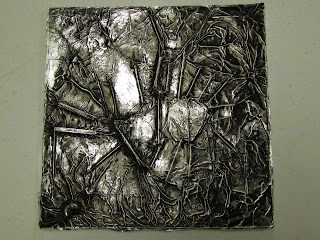The painting above wowed and amazed the people of Renaissance Florence. It is a fresco (a painting completed on wet plaster) by the young artist Masaccio and is the first painting to use the newly discovered linear perspective. Many people saw this painting on the wall of a church in Florence and thought that it was an extension into another room. Masaccio used linear perspective and shadowing of light and dark on the figures to create his illusion of depth. Masaccio was such a talented artist that it is rumored that he was poisoned! The competitive art world of Florence, Italy may have been too jealous of his talent.
Our class worked on a scene that created the same illusion of a deep space. Using different values and complimentary colors, we added shadows to flat circles to make them appear to be round spheres.
We then drew checkerboards using linear perspective, painted the background black, and added stars to make the illusion of infinite space.
Finally, we arranged the spheres so the largest were the lowest on the page, also adding to the illusion of depth.










































